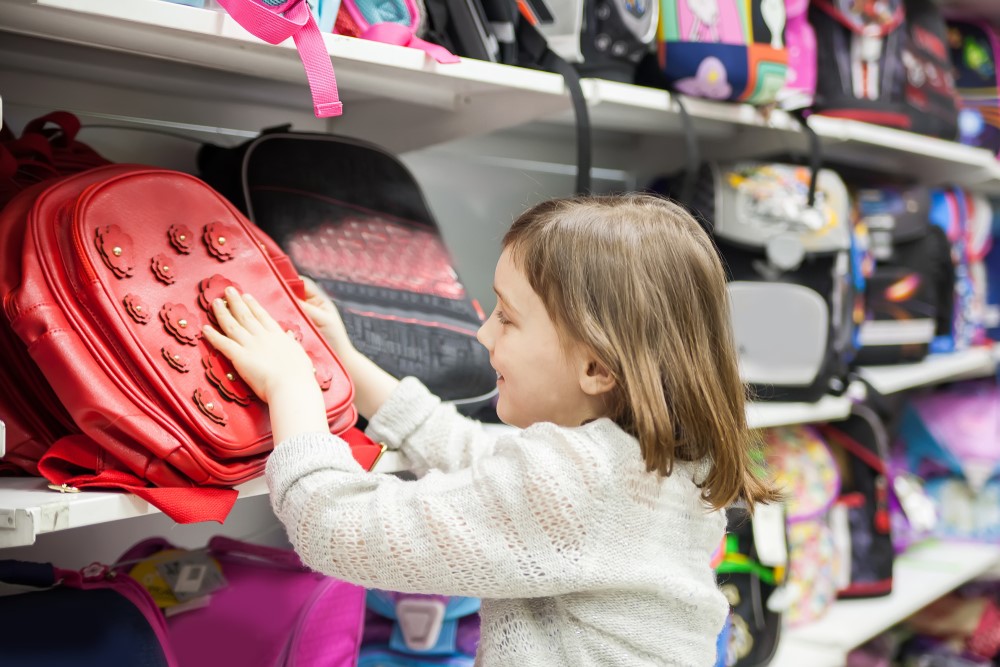Life Hack: Use Back to School Shopping to Teach Kids about Smart Spending
By Song • October 8, 2019
The yearly supply list is one of the many lists parents must check off for the upcoming school year . Kids in sports need gear, band members need uniforms and supplies, and most growing kids and teens need new clothes and shoes.
Depending on a child’s grade-level and involvement, back-to-school costs can soar beyond the budget. In fact, a 2019 report by Deloitte estimates that parents will spend on average more than $500 per child on supplies, clothes and other items for Back to School.
Kids don’t always understand that finances are limited . Instead, they may see what they want, not necessarily what they need. They also notice what their peers have and wear. Advertisements, social media influencers and the media may play a role in their ‘wants’ as well.
If parents aren’t cautious, back to school spending could quickly get out of hand. While many kids want to fit in with the crowd by wearing big brands, the pull of peer pressure can’t and shouldn’t override the financial bottom line.
Sometimes being a parent means drawing the line between wants and needs. Back to school shopping is one of the best times for parents to teach kids the difference between what they need and what they want ; those shopping lists can be a quick class in money management, too.
If your kid or teen has filled their back to school list with too many pricey items, here’s how to use the shopping experience to help them learn about spending and shopping smart.
Set a Budget
A back-to-school budget helps keep finances on track and may help limit spending. The budget should include total spending amounts for all expenses—supplies, clothes, shoes, etc.
Make sure the budget is realistic and that it doesn’t encroach on other monthly expenses ; this means that what you spend shouldn’t cut into the food, mortgage or other necessary expenses and financial obligations for the month.

Price Out the List
Parents should have teens and kids help them price out the list of supplies and other B2S items. What does this mean exactly?
Pricing out the list is all about discovering the real cost of every item on that list. This helps kids understand how much each item costs and how it affects the budget.
School supplies can be priced out first so that the estimated costs can be deducted from the overall budget. The remainder is what kids and teens will have to spend on the fun items like clothes and shoes.
Hunting for prices, though, will help kids see the real cost of an item and how it affects a budget.
Teach them How to Compare Costs
Pricing out each item also means learning how to compare costs. Help teens or kids research prices online and in-store. They may find better deals on clothes or supplies online, but some stores may have amazing in-store sales.
Kids can learn that shopping around helps them find the best deals —and stretch their dollars. But what about those big brands? Are they worth it? Your Teen magazine writer Michelle Icard notes that if the budget allows, parents may want to splurge on one or two hot brand items like shoes or jackets.

Teach Them to Budget with Cash
Teens tend to want to pick out their own clothes and shoes. Parents can purchase supplies—notebooks, pencils, etc.—and give teens the remaining balance to choose their other items.
Whatever is left over can be given to teens in cash as their budget. Parents can accompany them to the store to make sure that money isn’t spent on items not related to back-to-school.
Teens (and older kids) should be allowed to make some of their selections without parental influence. One of the shopping tips given by Self-Sufficient Kids is “let them make their own choices.” Giving kids this freedom is important because it helps them learn how to allocate their money. The unguided choices also could help them figure out their own sense of style.
Allow your kids to choose their clothes, shoes and backpack. What they select, however, must be paid for in cash from their own personal budget. Their selections cannot be more than their cash in hand.
A teen may choose an expensive shirt or pair of shoes only to discover that one item is all they could buy . You can explain to them why that one purchase is a bad decision, or you can let them continue with the choice. This is up to you (it’s your money)!
Be sure, though, that they keep the receipts in case they (or you!) have buyer’s remorse …and check the return policy!
Discuss the Purchases
After shopping, talk to kids and teens about their purchases. Did they buy a few items or did they get a lot for their allocated budget?
Their choices are a lesson. Next school year, buying a $50 t-shirt might not be the best choice. Ask them why they made certain buying decisions.
Use those decisions to talk to teens about budgeting in the future. Did teens/kids give up buying new pants or a new backpack to purchase pricier items?
If teens realize that they made poor shopping choices and they kept their receipts, take them back to the store and help them think about smarter purchases. Parents can help them pick items that maximize the budget.

Money Left Over
What if a teen or child has money left over from their budget? Instead of spending it, encourage them to put it into a savings jar (or bank account) for future needs.
A savings account is necessary for emergencies when they become an adult, so saving money is an important habit for them to establish . Explain that savings are meant to be used towards big expenses that hit unexpectedly. They may want to set aside their savings for college or a car.
Back to school expenses can be a big financial dent for parents. However, these yearly shopping trips can be the best time to teach kids about budgeting and smart spending. Set a budget and have kids research prices on every item on their list.
Understanding the price of each item teaches kids how that item affects their overall spending allowance. After all the necessities are priced, the remainder can be used for fun items like new clothes or shoes (unless these are truly necessities).
Take kids to the store and give them their cash allowance to spend on items of their choice. This helps teach them how their choices affect the budget. They may find that one shirt zeroes out their cash. If there is money left over, encourage them to save it up for future needs. Savings is an important asset to have as an adult, and saving money is a habit that should begin early.
Whatever choices they make, discuss with them the impact on the budget and maybe even their wardrobe. Instead of spending $50 on one shirt, they could have purchased two or three less expensive shirts. Shopping smart and spending wisely means staying on budget and getting the most out of every dollar.
More Resources
- Apply Online Now
- Title Loan Refinancing
- How Much Can I Get?
- Get Cash in California
- Get a Title Loan In Georgia
- Car Title Loans
- Title Loans in Utah
- 1(800)Car-Title-Loans
- Pink Slip Title Loan
- Get a Title Loan with an Old Car?
- Sacramento
- St Louis
- Get a Loan In Fresno
- Our Service Projects
- Find a Title Loan in Arizona
- Should I Get a Title Loan or a Payday Loan?
- What are My Title Loan Options
- Improve Your Credit with Title Loans?
- Se Hable Espanol
- Collateral Loans on your RV
- Get a Loan in Salt Lake City
- Get a Loan in Bakersfield
- Get a Loan in Idaho
- We’re Partners with Moneygram
- Different Programs
The post Life Hack: Use Back to School Shopping to Teach Kids about Smart Spending appeared first on (EN) 1(800) Car-Title®.
HOW MUCH IS MY CAR WORTH?













